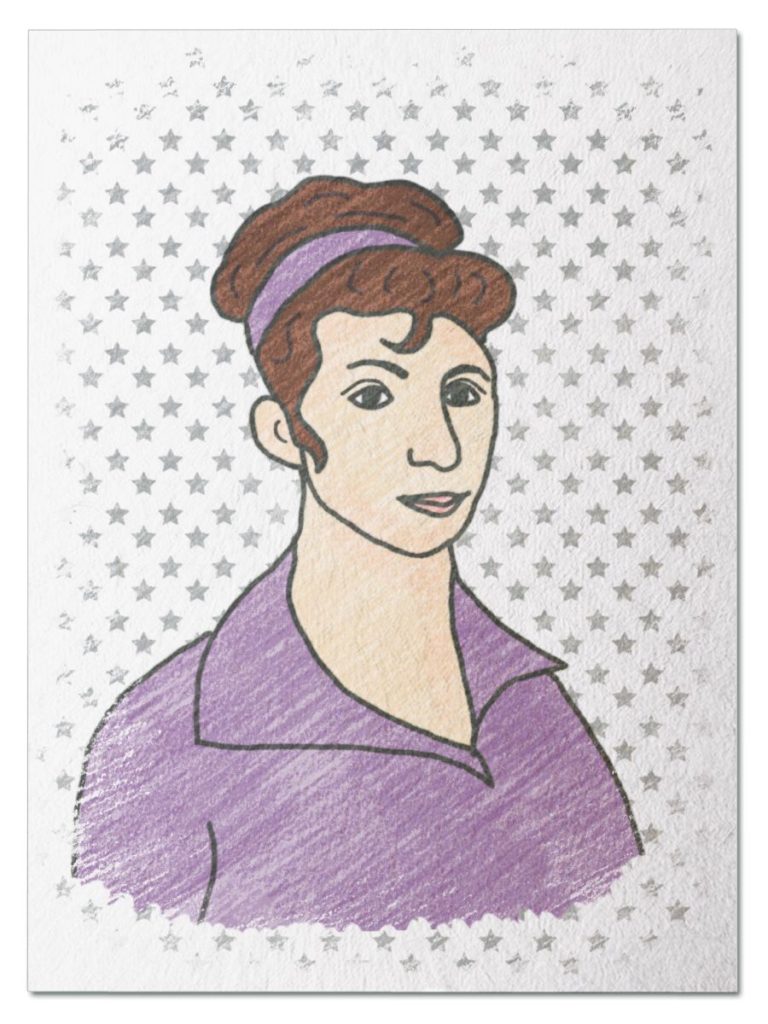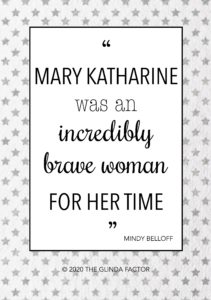
Passionate Patriot
In an era when women were discouraged from going to school or working outside the home, she ran a successful printing business in Baltimore. Her willingness to embrace the Patriot cause by publishing pro-Revolutionary materials led to a raid of her shop. She fought back, won, and became the only woman whose name is on the Declaration of Independence. Travel back to 1777 and watch Mary Katharine Goddard set the type for her historic printing of the Declaration of Independence…
Her Ruby Shoe Moment
The Power of the Wand
Her Yellow Brick Road
Brains, Heart & Courage
Glinda’s Gallery
Just the Facts
Her Ruby Shoe Moment
Mary Katharine Goddard carefully lifted the large piece of paper from her printing press and set it on the table. She put on her glasses and examined every inch of the document. If she was going to commit treason against the British King, she wanted her handiwork to be perfect.
On January 18, 1777, the Second Continental Congress granted Mary the right to print the Declaration of Independence, complete with the names of all Colonial delegates who approved it. This was a bold step. For the first time, the men who signed the Declaration of Independence became public knowledge (and considered traitors by England). And Mary added her full name to the bottom of the document as publisher: “Printed by Mary Katharine Goddard.” She permanently attached herself to the Revolutionary cause. There was no going back.

Goddard Broadside, Library of Congress
For most of history, Mary’s document has been called “The Goddard Broadside.” But she gave it the title,The Unanimous Declaration of the Thirteen United States of America. Mary arranged the text in two columns, then listed each colony and its delegates. The Goddard Broadside was the second official printing of the Declaration of Independence — the first took place in July of 1776 but didn’t include the signers’ names.
Mary probably got the commission through a combination of her good reputation and luck. She was one of the most prominent publishers during the Colonial days and had printed a few other broadsides for the Continental Congress. And her print shop was located down the block from the Henry Fite House, where Congress met for about two months after it was forced to flee Philadelphia. Mary worked quickly, completing the document within 2 weeks.
Congress ordered 13 copies of the Declaration of Independence — one for each Colony. It was the first official document intended for preservation. John Hancock instructed each Colony to include the Goddard Broadside as part of its official records and archives. Then, copies were hand-delivered to each of the 13 Colonies. Today, only 9 copies of the Goddard Broadside are known to exist.
Mary was a trailblazer, patriot, and accomplished businesswoman — printer, publisher, journalist, postmistress and bookseller. And she achieved this success during a time when women held few legal rights. Men dominated life in Colonial America. Back then, a married woman wasn’t considered to be a separate legal person from her husband and couldn’t own property, sign contracts, or keep her wages. So Mary stayed single. She worked around the system to become known as one of the best printers in Colonial America.
The Power of the Wand
In 2009, artist and printer Mindy Belloff recreated the Goddard Broadside. She spent almost nine months researching and printing her own copy of Katharine’s famous document. She handset over 7,000 characters of type, had special paper made for the project, and handprinted 100 copies. During the project, Mindy couldn’t help but wonder how Mary felt about printing a document that stated “All Men are Created Equal.” So on July 4, 2010, she printed another edition but changed the language to “All People are Created Equal.” And she thought that Mary would approve.
The debate continues today about what the founding fathers intended in the language of both the Declaration of Independence and Constitution. In fact, teens Rosdely Ciprian and Thursday Williams debated the issue every evening in the Broadway play, What the Constitution Means to Me. Rosdely was part of her middle school debate team and Thursday was involved in debate at NYU Law School. They traded off performances, appearing towards the end of the show to debate the meaning of the Constitution. The show was nominated for a Tony Award in 2019.
Her Yellow Brick Road
Mary spent her entire life in the family printing business, working side by side with her brother, William. She moved to Baltimore in 1774, where William founded the newspaper, Maryland Journal. Mary took over the printing business within a year of its creation. And it flourished under Mary’s leadership for about 10 years.
 In 1775, Mary made a bold move and publicly claimed her role in the newspaper. She started printing the Maryland Journal under her own name — “Published by M.K. Goddard.” She developed a reputation as a talented printer. She was also a thoughtful newspaper editor and was committed to publishing reliable information in a timely manner. By 1779, the Maryland Journal had the largest circulation of any newspaper in the American Colonies.
In 1775, Mary made a bold move and publicly claimed her role in the newspaper. She started printing the Maryland Journal under her own name — “Published by M.K. Goddard.” She developed a reputation as a talented printer. She was also a thoughtful newspaper editor and was committed to publishing reliable information in a timely manner. By 1779, the Maryland Journal had the largest circulation of any newspaper in the American Colonies.
Mary was also Baltimore’s only printer for many years. As a result, she printed a wide variety of publications for many different customers — books, almanacs, periodicals, broadsides, pamphlets (the list goes on and on). She also offered bookbinding services and ran a bookstore, where she sold journals, stationery, and dry goods. Legend says that John Adams was a customer of her bookstore.
While publishing the Maryland Journal, Mary also served as Baltimore’s postmistress for 14 years. In fact, she was probably the first woman to be employed by the federal government. Back then, it was common for printing and postal services to go hand in hand. Baltimore’s post office was one of the busiest in the Colonies. Under Mary’s leadership, it was also one of the most reliable postal services.

Franklin Printing Press, Smithsonian Institute
Business was tough for Mary during the Revolutionary War — the federal government didn’t always pay for her postal duties. But Mary still did whatever it took to deliver the mail, even paying the postal riders from her personal funds if necessary. Mary was also resourceful and kept the newspaper running during times of short supplies. She even offered to barter with subscribers, accepting:
“beef, pork, or any kind of animal food, Butter, hogs lard, tallow, bees-wax, flour, wheat, rye, Indian-corn, beans, buck-wheat, barley, hops, oats, vegetables, flat seed, wood, charcoal, tanned sheepskins, brown linen, lenses Woolsey, feathers, linen, and cotton rags.”
Mary was an advocate for the Patriot cause. She reported the events of the Revolutionary War, printed Congressional notices, and encouraged women to join the boycott of British textiles by making their own homespun cloth. But not everyone in Baltimore agreed with her views. The Whig Club threatened Mary and raided her print shop, in an effort to make her stop printing pro-Revolutionary sentiments. But Mary refused to back down. She took her complaint to the State Assembly in Annapolis and advocated for freedom of speech and freedom of the press. And she won.
Mary’s name disappeared from the newspaper in 1784. On January 2, 1784, both William and Mary were listed as publishers. Then, William was the only name listed just 4 days later. William forced Mary out of the business and declared himself publisher of the Maryland Journal. Mary filed five lawsuits against William but lost them all. They never spoke again. Mary struggled to earn a living after that. But she refused to give up and continued to operate her bookshop for about 20 years.
Brains, Heart & Courage
Mary grew up in a family of printers and postmasters. Her father (Dr. Giles Goddard) was the postmaster of New London, Connecticut for many years. And her younger brother, William, was a printer’s apprentice in New Haven. Luckily for Mary, her mother (Sarah Updike Goddard) was highly educated for the day. She taught Mary the basics of reading, writing and math. But she also enriched Mary’s education with French, Latin and classical literature.
Then, the family fell on hard times after Mary’s father died. They moved to Providence, Rhode Island, and Sarah loaned William the money to start its first newspaper. William was named as publisher of the Providence Gazette, but it was a family affair — Sarah controlled the finances and Mary ran the print shop. Mary published the Providence Gazette every week for six years. She also helped to fulfill William’s responsibilities as the postmaster of Providence.

A Colonial Postal Rider, National Postal Museum
After their mother passed away, Mary followed William to Philadelphia and then Baltimore. William relied on her to operate his printing businesses so he could focus on his grand idea — a Colonial postal service. He was convinced that the Crown Post censored letters and “lost” mail that had rebellious content. So William proposed that the colonies develop their own communication network.
William traveled all over the Colonies, trying to get support for his idea. His plan was finally approved by Congress in 1775, which laid the foundation for our postal service. William was disappointed, however, when Benjamin Franklin was appointed as the first Postmaster General. So William returned to his printing business, which was thriving in Mary’s capable hands.
Glinda’s Gallery
Just the Facts
- Mary was born on June 16, 1738 in New London, Connecticut.
- Mary remained single her entire life.
- Congress met in Baltimore from December 20, 1776 until February 27, 1777.
- Mary suddenly lost her position as Baltimore’s postmistress in 1789. Samuel Osgood, the new Postmaster General, decided the job was no longer suitable for a woman. So he fired Mary and appointed a friend to the position instead. Mary’s customers protested her removal — in fact, over 200 leading businessmen came to her defense (including the Governor of Maryland).
- Mary also wrote to George Washington, describing her loyal service and asking to be reinstated (the letter is in the National Archives). She complained that she was removed from the position for no reason. But nothing worked.
- Mary lived alone in Baltimore for the remainder of her days and continued to operate her bookstore. She was cared for by an enslaved woman named Belinda Starling. In her will, Mary granted Belinda her freedom.
- Mary died at age 78 on August 12, 1816 and is buried in Baltimore.
- Mary was inducted into the Maryland Women’s Hall of Fame in 1998.
Want to Know More?
Miner, Ward. “William Goddard, Newspaperman.” (Durham: Duke University Press, 1962).
Murphy, Sharon. Great Women of the Press. 1983.
Teller, Abbey and Christina Park. “Women in the Postal System.” National Postal Museum (https://postalmuseum.si.edu/research-articles/women-in-the-us-postal-system-chapter-1-women-in-postal-history-early-postal-women).
Trickey, Eric. “Mary Katharine Goddard, the Woman who Signed the Declaration of Independence.” Smithsonian Magazine, November 14, 2018. (https://www.smithsonianmag.com/history/mary-katharine-goddard-woman-who-signed-declaration-independence).
“March Highlight: Mary Katherine Goddard.” Declaration Resources Project at Harvard University (https://declaration.fas.harvard.edu/blog/march-goddard).
The Goddard Family Papers are located at the Rhode Island Historical Society.
“1777 Declaration,” by Intima Press.
